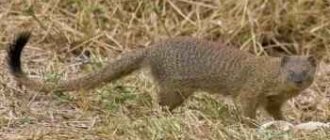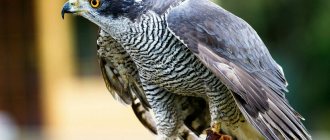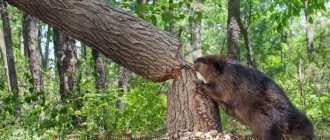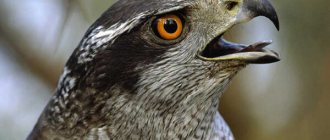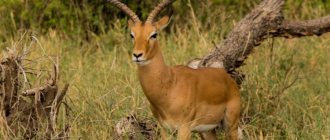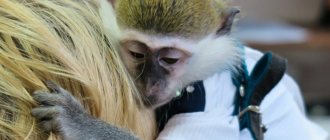Monkeys are mammals that have both legs and arms, therefore, in the anatomical structure of their body, they are similar to humans. In fact, they are called four-armed mammals. In addition, all monkeys are included in the order of primates. Nowadays, monkeys have a slightly different classification, therefore they are classified in the infraorder “Ape-like”, along with tarsiers. In this regard, they belong to the suborder “Dry-nosed primates”. All species of prosimians (with the exception of tarsiers) are represented by the suborder “Wet-nosed primates”
Monkeys: description
The brain of monkeys has a rather complex structure, therefore it is well developed and thanks to this they have the makings of intelligence. This is especially true in relation to great apes, who have a part in the brain responsible for the meaningfulness of movements. Most monkeys have binocular vision, and the whites of the eyes, like the pupils, are black. The dental system is similar to the human one, with some differences noted in some species. Apes have massive teeth, with a powerful root system.
Appearance
Depending on the species, the size of adults varies significantly: the Pygmy Marmoset has a body size of only 15 cm, while male gorillas have a body length of two meters or even more. The weight of the animals varies depending on the species. Therefore, there are species whose weight is no more than 150 grams, and there are species that weigh almost 300 kilograms.
Many species of monkeys (a significant part) prefer to lead an arboreal lifestyle (that is, they live in trees). They have a long back, a short and narrow chest, and a lightweight skeleton.
Gibbons and orangutans, on the contrary, have a fairly wide and massive chest and an equally massive hip part of the body. There are species of monkeys that have a tail longer than their body. Thanks to the presence of such a tail, these animals control their movements in the treetops. In other words, it serves as a kind of rudder for them. The species of monkeys that live on earth are characterized by the presence of a regular tail, but apes do not have a tail at all. All species of monkeys have a body covered with hair of varying lengths and thickness, depending on the species. Coat color also varies over a fairly wide range. Typically, with age, monkeys can turn gray, and some males become bald.
Interesting to know! These animals differ not only in coat color, but also in skin color. You can find monkeys, both flesh-colored, blue, bright red, and black and even multi-colored, which is typical for the mandrill.
Monkeys have a very mobile and well-developed upper body, including limbs, which have 5 fingers, like a human. A peculiarity of monkeys is that their thumb looks backward. The excellent physical development of all limbs is associated with the vital functions of these animals. The fact is that they spend most of their lives in trees. Excellent physical characteristics help them easily move from branch to branch, as well as from tree to tree. Baboons are characterized by long feet, which allows them to move easily and gracefully on the ground.
Behavior and lifestyle
Monkeys are social animals, but their behavior even today is considered poorly understood, although some behavioral features of these primates are known. It is known that tamarins and marmosets spend their entire lives in trees. Their nail plates are curved so that they resemble claws. Thanks to this, monkeys feel great in trees. Ring-tailed monkeys use their tail as a tool when they need to collect food from trees. They are simply held securely by their tail at any height and in any position, while working with their limbs.
Important point! Those species of monkeys that spend literally their entire lives in trees rarely come to the ground. As a rule, they find everything they need for life in trees.
In general, tree monkeys are modest in size and demonstrate amazing mobility and coordination of movements. Macaques and baboons, which live in Asia and Africa, feed on the ground, but move into the crowns of trees at night. Species Frilled baboons prefer to live in the most open areas, representing savannah and plateau. This category of monkeys is not distinguished by unique mobility and represents classic terrestrial primates.
Monkey intelligence
As a result of long-term scientific research and experiments, it has been established that great apes have a certain level of intelligence. It is believed that the intelligence of chimpanzees has been studied most deeply. Chimpanzees share 90 percent of their genetic makeup with humans. At one time, scientists planned to classify this species of monkeys into the genus “Humans,” since chimpanzees are so close relatives at the genetic level in relation to humans.
Unfortunately, chimpanzees have such a vocal apparatus that they are not able to reproduce sounds similar to human speech, but at the same time they can quite well communicate using gestures, symbols and lexigram language. Being in natural conditions, great apes use various tools to get food for themselves. Naturally, in the natural environment, besides sticks, it is difficult to find another tool for obtaining food. It should be noted that at any level of behavior, regardless of the relationships within the pack, complex forms of behavior are considered characteristic of them. These animals experience feelings that are characteristic of human feelings. These qualities are not possessed by any other species of mammals.
Interesting information! Japanese macaques, in order to protect themselves from severe frosts, find springs with hot water and plunge into them up to their necks. This demonstrates the incredible ingenuity of this species.
As a rule, monkeys try to form herds or packs, which requires constant communication between members of this community. They receive the necessary information thanks to a special secretion secreted by the odorous glands. Despite this, they find understanding among themselves, both with the help of sounds and with the help of gestures, as well as facial expressions. By cleaning their wool with each other, they not only solve hygiene issues, but also strengthen relationships within the group between specific individuals.
How long do monkeys live?
Living in natural conditions, the average life expectancy of primates is about 50 years, but in artificial conditions, if all the rules of maintenance are followed, they live longer, although not by much. However, life expectancy may vary depending on the species and habitat. Primates, like humans, experience the same developmental stages in their lives.
Important fact! Many individuals do not live to see 50 years of age because they are constantly in danger. They die from injuries, from attacks by predators, as well as from human activity.
Almost until the age of 5, the juveniles are completely dependent on their mothers, when they begin a new stage of development. From the age of eight they begin the teenage stage of development, and at the age of sixteen individuals become sexually mature. From this period, primates enter an independent stage of life, as they become fully adults.
10 Most Interesting Facts About Monkeys
Types of monkeys with photos and names
The infraorder of monkeys includes two parvoorders:
- Broad-nosed monkeys (Platyrrhini).
- Narrow-nosed monkeys (Catarrhini).
Currently, more than four hundred species of monkeys are known. At the same time, there are the most famous and unusual ones, such as:
Black howler monkey (Alouatta caraya)
Representing the "Arachnid" monkey family. The natural habitats of this species are Paraguay, Bolivia, Brazil and Argentina. A feature of the species is their ability to create quite loud sounds, in the form of a roar. The coat color of males is mostly black, but females have a yellow-brown or olive coat. Adults grow in length up to 70 centimeters maximum, with a weight of about 7 kg, no more, while females are somewhat smaller, both in weight and in size. The basis of the diet of these animals is foliage and fruits.
Mourning capuchin (Cebus olivaceus)
It belongs to the family of “Tail-tailed” monkeys and lives in the untouched forests of Venezuela, Brazil and Suriname. Males gain weight within 3 kilograms, and females weigh no more than 2 kilograms. The fur of these animals is colored brown or light brown, with inclusions of a grayish tint. In the head area you can see a triangle formed by black hairs. Animals of this species are prone to infacticide, when their young are deliberately killed. Individuals protect themselves from blood-sucking insects by rubbing their fur with poisonous centipedes. The species feeds on almost everything that gets in their way.
Blue monkey (Cercopithecus mitis)
Found in woodlands or bamboo plantations on the African continent. The monkey's fur is gray with a blue tint, and there is a white stripe above the eyebrows, which looks like a crown. Adults reach a length of about 70 cm and weigh no more than six and a half kilograms. Males have clearly visible white whiskers, as well as relatively long fangs.
White-handed gibbon (Hylobates lar)
It represents the family of the same name and prefers to live in the forest tropics of China and the Malay Archipelago. Adults are slightly more than 60 cm long and weigh no more than 6 kilograms. The main coat color is black or brown, but the arms and legs are always white. The family feeds on leaves, fruits and various insects.
Eastern gorilla (Gorilla beringei)
It is considered one of the largest monkeys found on the planet. The height of individuals reaches 1 meter 90 centimeters and weighs more than 150 kilograms. This massive animal has a large head, broad shoulders, an open chest and long legs. The main coat color is black, but some subspecies of gorillas are characterized by the presence of a bluish tint. On the back of adult males you can see a strip of silver-tinged fur. The diet includes mushrooms, plants and fruits, as well as invertebrates.
Pale saki (Pithecia pithecia)
Represents broad-nosed monkeys. Saki is distinguished by long and shaggy hair, while adult individuals do not grow more than 50 cm in length and weigh no more than 2 kilograms. The main part of the body coat is black, while the face is pink or pure white. Females have lighter shades, leaning more towards grey, but they also have a distinct complexion, with lighter shades. They feed mainly on fruits and seeds of plants, and their habitat is confined to Venezuela, Brazil and Suriname.
Hamadryas (Papio hamadryas)
Represents the species of narrow-nosed monkeys and the genus “Baboons”. The habitat extends to the Asian and African continents. They grow in length to almost 1 meter and weigh about 30 kilograms. Males have a unique coat distribution, which is reflected by the presence of elongated hair on the shoulders, as well as on the chest. Females are characterized by a darker coat color.
Japanese macaque (Macaca fuscata)
The name itself indicates where this animal prefers to live. The macaque's natural habitat is associated with the northern part of the island of Honshu, although not many individuals have been introduced to Texas. Adult males grow up to a meter in length and can weigh no more than 15 kilograms. These primates have bright red skin, which can be seen in the muzzle area, as well as on the buttocks, since these areas do not have hair. The rest of the body is covered with thick fur of a dark gray shade, with inclusions of a light brown color.
Common chimpanzee (Pan troglodytes)
It is a species of monkey that lives in forests with a tropical climate, as well as in Africa, within the humid savannah. The species is distinguished by the fact that its body is covered with coarse and stiff fur of a dark brown color. Within the mouth and tip, the coat is almost white, and the feet, muzzle and palms are hairless. Although the common chimpanzee is an omnivore, the basis of its diet consists of plant foods.
Pygmy marmosets are of particular interest because they are the smallest monkeys on the planet. Their natural habitats extend to the forests of South America.
Range, habitats
Monkeys are animals that can be found on almost all continents, as well as in Europe, Asia, Africa, in the tropics and subtropics of the South and Central America, and Australia. It is impossible to meet monkeys only in Antarctica.
- Chimpanzees can actually be found in such countries of Central and Western Africa as Guinea and Senegal, Angola and Congo, Chad and Cameroon and some others.
- Macaques inhabit fairly large territories, extending from Afghanistan to Southeast Asia and Japan. Macaques can be found in North Africa and Gibraltar.
- The gorilla's habitat is associated with the equatorial forests located in Central and Western Africa, with part of the population living in Cameroon and Gambia, as well as in Chad and Mauritania, including Guinea and Benin.
- The islands of Sumatra and Kalimantan are home to orangutans, especially their rainforests.
- Howler monkeys are found mainly in countries such as Southern Mexico, Brazil, Bolivia and Argentina.
- Southeast Asia represents the natural habitats of the monkey. It is also found throughout the Arabian Peninsula, on the African continent, as well as Gibraltar.
- Almost all types of gibbons are common in the Asian part of the continent. Their natural habitat extends to the forested areas of Malaysia and India, as well as the tropical rainforests of Burma, Cambodia, Thailand, Vietnam and China.
- Almost the entire African continent is inhabited by hamadryas (baboons). Moreover, this is the only species of primate that inhabits northeast Africa and is found in countries such as Sudan and Egypt, including the Arabian Peninsula.
- The distribution range of capuchins is associated with vast expanses of jungle, including the territory of Honduras and ending with the territories of southern Brazil and Venezuela.
- Baboons are found in the east and center of the African continent. These are countries such as Kenya and Uganda, Ethiopia and Sudan, Congo and Angola.
- In South America, in Colombia, Venezuela and Chile, saki monkeys are found as typical representatives of these places.
Tamarins live in the warmest regions of Central America, Costa Rica, as well as South America. They are also found throughout the Amazon basin, with some species found in Bolivia and Brazil.
Popular message topics
- The Work of Jane Austen
Jane Austen was born in England on December 16, 1775. Since childhood, the girl’s parents instilled in her a love of classical works. - Homoptera insects
Homoptera insects are of little benefit to humans. They are capable of destroying crops and carrying a variety of, sometimes even fatal, diseases. There are 30 thousand species of these insects. - The city of Novokuznetsk
In the southwest of Siberia, in the southern part of Kuzbass is the city of Novokuznetsk. Kuznetsk fort was founded in 1618, and in 1622 received the status of a city and the name Kuznetsk-Sibirsky. In 2022, the population of Novokuznetsk was 552 thousand people.
Monkey diet
Monkeys are four-armed mammals whose diet is based on plant foods. As a rule, monkeys feed on fruits, leaves, flowers, and roots of various plants. Some species of monkeys easily eat small invertebrate animals and insects to diversify their diet. Some species eat special food, which is associated with the unique process of animal evolution.
Thus, marmosets happily feed on gum, which they find in places where tree trunks or branches are damaged. Monkeys easily get to the sweet plant juice by gnawing holes in the bark of trees, after which they lick this juice with their tongue. Red-backed sakis love to feast on hard fruit seeds. In order to split them, monkeys use a special interdental gap, which functions like ordinary tweezers.
Howler monkeys and howler monkeys have adapted to eating fairly hard and non-nutritious tree foliage. The stomach of such monkeys consists of several parts separated by partitions, which resembles the digestive system of ruminants.
Interesting fact! During evolution, some species of monkeys have developed so-called cheek pouches designed to store large amounts of food.
Thanks to this structure of the digestive tract, food travels a much longer path, so tough foliage is digested more efficiently. As a rule, such stomachs of leaf-eating monkeys contain all the necessary bacteria and microorganisms that help actively break down cellulose.
Reproduction and offspring
As a rule, almost all species of monkeys exhibit well-defined sexual dimorphism, which is represented by brighter body color and larger sizes of male individuals. And, nevertheless, in different species the manifestation of sexual dimorphism is of a different nature. Differences between females and males are most pronounced in polygynous species, where strict male dominance is evident. These types of monkeys include proboscis monkeys and baboons.
For monkeys that form herds, sexual dimorphism is less pronounced if the males in the herd are not overly aggressive. These monkeys include gorillas and macaques. Species that live in pairs have the same minor differences, when the female and male take part in caring for their offspring. These are monkeys such as marmosets, marmosets and tamarins.
Interesting to know! In monkeys, compared to other species of mammals, the entire troop is involved in raising the young. In marmoset monkeys, most of the care for the growing offspring falls on the shoulders of the male.
Howler monkeys and capuchins unite in flocks with a clear hierarchical structure, and the gestation period, regardless of the species, does not differ significantly. Marmosets have a gestation period of about 145 days, while baboons have a gestation period of about 175 days. Almost all species of monkeys give birth to one baby. But there are exceptions here, since marmosets and tamarins quite often give birth to twins. As a rule, at first the offspring clings to the mother's fur and feeds, being in constant motion.
Plot - summary:
- A friend gave the narrator his monkey, and the boy brought it to his house.
- It became very restless at home with Yashka, the monkey jumped on the cabinets, slept in the bed, stole sugar and candy, and quarreled with dad.
- Yashka had various adventures with the guests who came to the house. The monkey stole potatoes from the doctor, ruined the hair of an important lady, and cleaned the windows with a hedgehog.
- With the onset of spring, Yashka began to be let out for a walk in the yard, where the monkey scared everyone, including the yard dog and the stray cat.
- And when autumn came, everyone in the house forced the boy to find a new home for Yashka, and they gave the monkey to another owner.
Natural enemies of monkeys
Some species of monkeys are kept in captivity as pets, so they are constantly caught in the wild and illegally imported to different countries, where they are sold for big money. Some large species are used in laboratories, research institutes and industrial concerns, and therefore are also removed from the natural environment.
Active human destruction of the natural habitats of wild animals poses one of the greatest threats to monkeys. As an example, we can cite China, where the total number of langurs has decreased significantly due to massive deforestation. Because of this, the Chinese government has imposed a ban on hunting, and has also established several protected areas.
As for the largest species, they have practically no natural enemies, but they often die from aggressive manifestations of individuals from neighboring flocks. Medium-sized individuals as well as small species are affected by many wild cats such as leopard, jaguar, lion, tiger, etc. In addition, they are preyed on by large reptiles such as snakes and boa constrictors, as well as pythons. On occasion, a crocodile can attack them. In the vast expanses of South America, as well as on the islands of the Philippine archipelago, birds of prey, such as monkey-eating eagles, hawks, kites and crowned eagles, hunt monkeys.
It is important to know! Monkeys, like humans, suffer from various ailments, such as influenza, herpes, tonsillitis, tuberculosis, hepatitis and many other infectious diseases, including rabies.
Therefore, we can draw a line and conclude that almost all types of monkeys are dependent on various negative natural factors, as well as on the actions of people who hunt monkeys for valuable fur and tasty meat. Many farmers simply shoot the monkeys because they raid their plantations. Great damage to the population of these mammals is caused by the practice of capturing individuals for the purpose of trade.
Well, just a copy!
Monkeys are the closest relatives of humans - their DNA is 99% identical. Even their social behavior and interactions with other primates bear striking similarities to humans.
Appetizing cakes with a creamy texture in the form of cute flowers
Emigration to the USA and an unsuccessful marriage: how the life of the beauty Natalia Lapina turned out
To avoid harm to health: choose frying oil with a high smoke point
Monkeys are very intelligent creatures, second only to humans. Previously, tool use was thought to be a human ability. However, numerous studies have shown that in the wild, primates such as chimpanzees are capable of catching ants with branches. A huge number of experiments have been conducted that show that monkeys can hunt with spears and communicate in sign language.
They are so skilled that even in captivity they can outperform college students on basic memory tests.
Populations and species status
In the International Red Book you can find information about some species of monkeys that belong to the order “Primates”. For example:
- About the black hairy saki (chiropotes satanas).
- About the gorilla (Gorilla gorilla).
- About the orangutan (Pongo pygmaeus).
- About chimpanzees (Pan troglodytes).
- About the Lapunder macaque (Macacus nemestrinus).
- About the macaque Silenus (Macacus silenus).
- About the Rhesus macaque (Macacus muatta).
- About the Javan macaque (Macacus fascicularis).
- About the Japanese macaque (Macacus fuscata).
- About Allen's monkey (Allenoptihecus nigroviridis).
- About Diana's monkey (Cercopithecus diana).
- About the proboscis monkey (Nasalis larvatus).
- About the Guinea baboon (Papio papio).
- About the Black Sulawesi baboon (Cynopithecus niger).
Some Gibbons are also under protection, including the White-handed Gibbon, the Silver Gibbon, the Black-handed Gibbon, as well as part of the Tarsier and Marmoset species.
Relationships between apes and humans
Since ancient times, relations between humans and monkeys have somehow not worked out, despite the fact that these four-armed mammals are very similar to humans. Man has never stopped hunting these animals, since monkey meat is acceptable to eat. This animal was simply exterminated en masse, as the most dangerous animal in relation to agricultural crops, since they raided plantations and destroyed most of the crop. Gorilla paws were also highly valued, as they were used to make various crafts for tourists. Naturally, the fur of these mammals was especially valued.
For Hindus, these animals have the status of sacred, so they do what they want and get away with it all. In Thailand, trained monkeys are widely used to collect fruits from coconut trees. Recently, the practice of keeping exotic and rare animals at home has become widespread. This fashion for exoticism has not spared monkeys either. Due to this, a large number of poachers around the world are involved in capture and illegal trade in many countries. Because of this, a huge number of individuals are being removed from nature, which has led to some species being on the verge of extinction. Therefore, it is not surprising that these species are listed in the International Red Book.
Simien Mountains National Park, Ethiopia
Home to the rare gelada baboon, Simen Mountains National Park is a UNESCO World Heritage Site located in the Amhara region of northern Ethiopia.
This park has mountains characterized by spectacular jagged mountain peaks, deep valleys and suddenly opening 1500m chasms - thanks to millions of years of active erosion. Other notable sights in the Simeon Mountains National Park are the walia goat, the Simeon fox, and the bearded vulture, among other 54 species.


